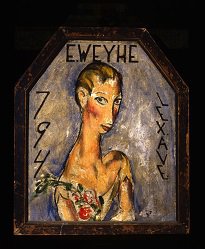
Alfred Henry Maurer, 1868 – 1932
“Jeanne,” ca. 1904.
Oil on canvas, Crystal Bridges Museum of American Art
A new exhibition opened recently at Crystal Bridges features some 65 paintings by American Modernist Alfred Maurer. Visitors to Crystal Bridges’ permanent galleries may have noticed the wide range of paintings under Maurer’s name. His career, though short, was remarkably diverse. He started out making realistic paintings in the popular manner of William Merritt Chase, a style that garnered him awards and acclaim. However, after moving to Paris, he became enamored of the European Modernist style known as “Fauvism.” The Fauvists abandoned realism in their color choices, and painted brightly-colored landscapes and abstract works that earned them the name “les fauves,” or “the wild beasts.” From Fauvism, Maurer went on to experiment with other avant-garde styles, changing his approach again and again throughout his career. Alfred Maurer: Art on the Edge really gives guests an opportunity to take in the scope of Maurer’s work and appreciate his exploration of modern styles. The exhibition is on view through January 4, 2016.

Alfred Henry Maurer, ca. 1931 / unidentified photographer. Bertha Schaefer papers and gallery records, 1909-1975, bulk, 1940-1965. Archives of American Art, Smithsonian Institution.
Alfred Maurer was born in 1868. His father, Louis Maurer, was also an artist and made his living working as an engraver, first with Courier and Ives, and later forming his own company. Louis was a critical and domineering father, who expected his son to follow in his footsteps. He withdrew Alfred from school at the age of 16 and put him to work in the family business. Despite his father’s pressure, in 1897 Alfred left for Paris. He remained there for nearly 17 years, an active participant in the avant-garde society that centered around Leo and Gertrude Stein. It was there he became interested in European Modernists such as Matisse and Picasso, and his work changed from the realistic depictions of his early career to a looser, Impressionistic style, and then to the abstraction and bold colors of the Fauves. The artistic atmosphere of Paris suited Maurer, and though he was sometimes obliged to design rugs for extra cash, it seems he was content there. However, the advent of the Great War forced Maurer to make a hasty departure for New York in 1914, leaving behind some 250 paintings in his Paris studio. He was never able to return to Paris, and his father refused to pay to have his paintings shipped home to New York. In 1925, Maurer’s French landlord sold the entire collection for back rent. Some 45 of these paintings were later discovered in assorted flea markets, antique stalls, and junkshops. Most of the others vanished from history.
In New York, Alfred occupied a single room in his family home that served as both bedroom and studio. He was encouraged by a few friends such as fellow painter Arthur Dove and gallerist Alfred Stieglitz; but endured constant harsh criticism of his work from his father, who denigrated his Modernist style. Maurer’s biographer, Elizabeth McCausland, wrote that Alfred’s father would “take the brush out of Maurer’s hand to improve his work….He would go into the room, to stand in front of Alfy’s paintings and vituperate them.”
During the first ten years in New York, Maurer rarely exhibited his work rarely. But in 1924, gallerist Erhard Weyhe unexpectedly purchased every painting in Maurer’s studio—more than 200 works—to exhibit in his New York Gallery. Though the works seem to have sold well (20 canvases were sold before the opening of his first show), Maurer continued to receive lukewarm responses from critics. One, flummoxed by his Cubist still lifes, wrote that they looked “as though they had been assembled by a highly nervous person in the midst of a cyclone.”

Alfred Henry Maurer, 1868 – 1932
“Still Life with Pears,” ca. 1930-1931
Oil on board
Addison Gallery of American Art
In April, 1932, Alfred was admitted to the hospital for a series of surgeries, concluding with a prostatectomy, and was discharged in late June. His friend Dove later wrote to Stieglitz that he had visited Maurer and “could see that he could not stand it to live.” When Louis Maurer, then 100 years old, died on July 19, Alfred’s family did not tell him; he discovered it for himself in the newspaper a few days later. Though Alfred said his father’s death “did not bother him,” Dove speculated that “not telling him probably made him feel that he was in worse shape than he thought.” On August 4, Alfred hanged himself in the doorway of the room that had been his little upstairs studio. The reason for his suicide was never known. Whatever shadows troubled him, Maurer never ceased in the pursuit of his artistic vision: one which drove him to constantly expand and evolve. Upon his death, he left behind more than 600 paintings. In 1950, artist Hans Hoffman wrote: “Maurer is a painter of enormous stature. His vision of the reality of painting drove him to leave behind the success that accompanied his earlier work. This is the tragedy and glory of every great man; he must follow an inner urge of deeper purpose which may destroy him in order that the work may live.”






